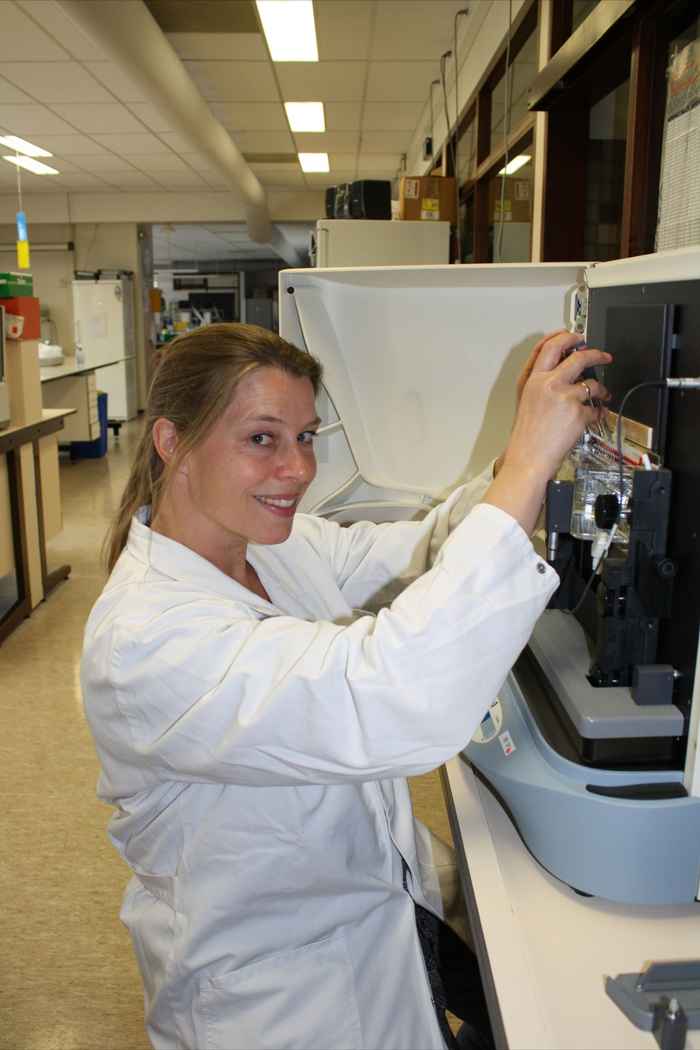Hedwich Teunissen
Molecular biologist at Naktuinbouw

PhD student in Amsterdam
After having completed a study programme in Selective Plant Breeding at Wageningen University, Teunissen obtained an appointment as PhD student at the University of Amsterdam. ‘My research focused on the interaction between Fusarium oxysporum and the tomato plant, the gene-for-gene relationship between plant and fungus. My period at the UvA has been one of the best experiences of my life so far. We worked hard, but the university also organised lots of great events. We celebrated Sinterklaas with presents, poems, and Bishop’s Wine in the lab.’ She concluded her PhD period in style, with two professors acting as doctoral thesis supervisors.
‘It was a quite different atmosphere compared to the period later when I worked as a post doc in Germany. Although I got along with everyone and my colleagues were all nice people, it seemed as though everyone was mainly focused on themselves and their own careers. I really started wondering whether I felt at home in the academic world.’
Exit academia
‘That was quite a tough decision, to be honest. I wasn’t sure whether or not I wanted to pursue a further academic career. During my time as a post doc in Germany, one of my fellow students sent out an email with a job vacancy advertisement from Naktuinbouw, who were looking for a molecular biologist. I was pregnant with my first child at the time, and thought: ‘Why not give it a try’. I’ve never regretted my decision since. I’m less prone to the financial uncertainty that comes with temporary research contracts, and I feel closer to the “real world” because we work on research projects that are based on concrete questions from companies.‘

Pioneering role
‘When I took on this job, the position had just been created, which was a great challenge. The lab already existed, but I had to set up a new facility for DNA-based variety identification in 2004. The facility served as a bridge between the R&D department and the variety research department. The latter assesses external factors to determine whether a new variety is homogenous, differentiated and stable. The R&D department already operated at molecular level, but those activities were limited to identifying plant pathogens, i.e. the presence of viruses, fungi or bacteria in a plant. I was responsible for determining the identify of plants and plant varieties at the lab.’
‘I was working on my own, so it was all up to me to find the best way of doing things: Which technology should we use? What sort of equipment would be most suitable? We opted for the AFLP (Amplification Fragment Length Polymorphism), a technology developed by Keygene. We became licence holders, which makes our position quite unique: We’re the only company in the Netherlands licensed to offer these types of AFLP services.’
Green Forensics
The department was initially set up to help chart genetic diversity within varieties more effectively in order to support variety research. Over time, it started to take on assignments from the business sector. Now, eight years after its establishment, Teunissen’s Green Forensics Team employs two researchers and three analysts, and offers three unique areas of expertise:
- Variety tracer: research on the basis of external characteristics and/or DNA to aid the enforcement of plant breeders’ rights. ‘Let’s say you’ve patented your variety, and are worried the company next door is selling your product illegally. We can conduct an extensive study to determine whether they are actually selling “your” variety. We work independently and provide our clients with support straight through to any courtroom.
- Pathogen tracer: the study of pathogen outbreaks. Sometimes, a plant variety is suddenly affected by an outbreak of disease. Such outbreaks can simultaneously occur in multiple locations. Obviously, it then becomes important to identify the source. Are the outbreaks related, or a mere coincidence? ‘We can help answer those questions by detecting whether the pathogens are genetically related, ’ Teunissen explains.
- Origin tracer: the study of product origin. Are Dutch strawberries really grown in Dutch soil? Teunissen explains: ‘We use stable isotopes – oxygen and hydrogen – to determine where the crops were grown. Our clients include both wholesalers and inspectorates.
‘The combination of these three elements allows us to apply multiple techniques and methods to solve any problem and find out what we want to know. These techniques are also applied in human forensics. When a body is discovered, forensic scientists try to establish where the individual was originally from. However, the Netherlands Forensic Institute’s focus is limited to humans, and ours extends to the entire vegetable kingdom!'
Green Life Sciences Hub
Naktuinbouw's Green Forensics department is part of the Green Life Sciences Hub (GLSH). The GLSH was initiated by the University of Amsterdam, Naktuinbouw and the Amsterdam Chamber of Commerce, with support from the Amsterdam Economic Board, and is aimed at stimulating the transfer of scientific knowledge to the green business sector.